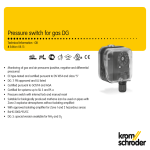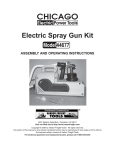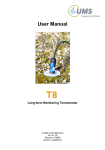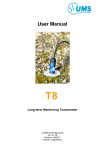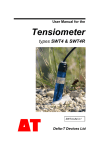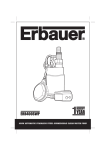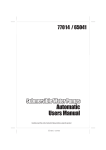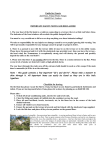Download Central Pneumatic 92037 Operating instructions
Transcript
Mini Detail Spray Gun 92126 ASSEMBLY AND OPERATING INSTRUCTIONS Distributed Exclusively by Harbor Freight Tools® 3491 Mission Oaks Blvd., Camarillo, CA 93011 Visit our Web site at http://www.harborfreight.com Copyright© 2004 by Harbor Freight Tools®. All rights reserved. No portion of this manual or any artwork contained herein may be reproduced in any shape or form without the express written consent of Harbor Freight Tools. For technical questions and replacement parts, please call 1-800-444-3353. Specifications Cast Aluminum Body and Construction Cup; Brass Nozzle Includes Cleaning Brush and Wrench Operating Pressure 20-50 psi Air Inlet 1/4” NPS Features Capacity Air Consumption Net Weight Adjustable nozzle 4 oz. gravity feed cup 3 CFM @ 50 psi 0.8 lb. Save This Manual You will need the manual for the safety warnings and precautions, assembly instructions, operating and maintenance procedures, parts list and diagram. Keep your invoice with this manual. Write the invoice number on the inside of the front cover. Keep the manual and invoice in a safe and dry place for future reference. Safety Warnings and Precautions WARNING: When using tool, basic safety precautions should always be followed to reduce the risk of personal injury and damage to equipment. Read all instructions before using this tool! 1. Keep work area clean. Cluttered areas invite injuries. 2. Observe work area conditions. Do not use this sprayer in damp or wet locations. Don’t expose to rain. Keep work area well lit. Do not use air compressors in the presence of flammable gases or liquids. 3. Keep children away. Children must never be allowed in the work area. Do not let them handle air lines, machines, tools, paint, or extension cords. 4. Store idle equipment. When not in use, tools must be stored in a dry location to inhibit rust. Always lock up tools and keep out of reach of children. 5. Use the right tool for the job. Do not attempt to force a small tool or attachment to do the work of a larger industrial tool. There are certain applications for which this tool was designed. It will do the job better and more safely at the rate for which it was intended. Do not modify this tool and do not use this tool for a purpose for which it was not intended. 6. Dress properly. Protective, electrically nonconductive clothes and nonskid footwear are recommended when working. Wear restrictive hair covering to contain long hair. 7. Use eye protection. Always wear ANSI approved impact safety goggles. Wear an ANSI approved dust mask and respirator when working around paint spray, chemical dusts and mists. SKU 92126 For technical questions, please call 1-800-444-3353. Page 2 8. Do not overreach. Keep proper footing and balance at all times. Do not reach over or across running machines. 9. Maintain tools with care. Keep tools maintained and clean for better and safer performance. Follow instructions for lubricating and changing accessories. Inspect tool cords periodically and, if damaged, have them repaired by a qualified technician. The handle must be kept clean, dry, and free from oil and grease at all times. 10. Disconnect power. Disconnect tool from air supply when not in use. 11. Remove adjusting keys and wrenches. Check that keys and adjusting wrenches are removed from the tool or machine work surface before connecting it. 12. Stay alert. Watch what you are doing, use common sense. Do not operate any tool when you are tired. 13. Check for damaged parts. Before using any tool, any part that appears damaged should be carefully checked to determine that it will operate properly and perform its intended function. Check for alignment and binding of moving parts; any broken parts or mounting fixtures; and any other condition that may affect proper operation. Any part that is damaged should be properly repaired or replaced by a qualified technician. Do not use the tool if the trigger does not operate properly. 14. Replacement parts and accessories. When servicing, use only identical replacement parts. Use of any other parts will void the warranty. Only use accessories intended for use with this tool. Approved accessories are available from Harbor Freight Tools. 15. Do not operate tool if under the influence of alcohol or drugs. Read warning labels on prescriptions to determine if your judgment or reflexes are impaired while taking drugs. If there is any doubt, do not operate the tool. 16. WARNING: The brass components of this product contain lead, a chemical known to the State of California to cause birth defects (or other reproductive harm). (California Health & Safety code § 25249.5, et seq.) 17. Maintenance. For your safety, service and maintenance should be performed regularly by a qualified technician. 18. Compressed air only. Never use compressed gas as a power source. 19. Do not spray near open flames, pilot lights, stoves, heaters, or any other heat source. Most solvents and coatings are highly flammable, particularly when sprayed. SKU 92126 For technical questions, please call 1-800-444-3353. Page 3 Warning: The warnings, cautions, and instructions discussed in this instruction manual cannot cover all possible conditions and situations that may occur. It must be understood by the operator that common sense and caution are factors which cannot be built into this product, but must be supplied by the operator. Special Warnings About Paint Sprayers Health and Safety Nature and Cause of Hazard Hazard Risk of Explosion or Fire from Flammable Materials. Spraying paints, solvents and thinners mixes them with oxygen in the air. This creates a more explosive mixture than these materials in their fluid form. Rapid fires and explosions of these mixtures can cause death or severe injury as well as significant property damage. Risk of Fire or Explosion from Incompatible Materials. Certain solvents, including Methylene Chloride and 1,1,1-Trichloroethane can chemically react with with the Aluminum used in this spray equipment. This can cause an explosion which may result in death or serious personal or property injury. Other chemicals, when mixed, may cause unpredictable results. Inhalation Hazard. Inhaling solvents or sprayed materials may cause severe injury to the lungs or body, due to their chemical make up or the fact that they may coat the interior of the lungs. Risk of Ejected Objects or Sonic Injury. Risk of Injection Injury. Many components of this tool and any air pressure powered tool are under significant air pressure, even after the air supply is disconnected. A significant risk of injury caused by ejected components or materials diverted by the stream of air pressure exists. High pressure air escaping suddenly may cause hearing injury. Air powered spray guns operate at high pressures and high ejection velocities. It is possible for sprayed material to be injected into the skin, which can result in serious personal injury. Highly pressurized sprays may damage property or injure persons. Prevention of Hazard Never spray materials near fire, flame, electrical spark or any ignition source. Never smoke when spraying or in the vicinity of spraying. Never smoke unless the area has been thoroughly aired out. Always provide good ventilation during and after spraying to eliminate any enclosed explosive atmosphere. Inform yourself by reading the documentation provided with each solvent before introducing to the sprayer. Never spray the named solvents in this sprayer. Never use these materials for cleaning equipment. Never use any solvent if in doubt of its composition or compatibility with Aluminum, other materials or this spraying equipment. Use an ANSI approved ventilator or face mask. NOTE: Some face masks, such as paper filters provide only limited protection against harmful sprays and fumes. Consult safety documentation provided with the materials you are spraying or an industrial safety expert when determining the appropriate respiratory protection. Before doing any service, inspection, or maintenance to the sprayer, dis-connect it from the air supply. Never point the nozzle toward any person or animal. Always wear ANSI approved safety goggles when using or servicing this tool. Always wear hearing protection when using or servicing this tool or any air pressure equipment. Never point or spray toward any person or animal. Never place your hands, fingers or any part of your body in front of the spray nozzle if the spray gun is not disconnected and depressurized. Test spray on scrap material before spraying work material. Unpacking When unpacking, check to make sure the following parts are included. Mini Detail Spray Gun Paint Cup with Lid If any parts are missing or broken, please call Harbor Freight Tools at the number on the cover of this manual. SKU 92126 For technical questions, please call 1-800-444-3353. Page 4 Assembly First, prepare your air supply. 1. This tool operates within a pressure range of 20 - 50 psi, and consumes 3 CFM of air at 50 psi. Provide yourself with a compressed air supply which will meet these requirements. DO NOT EXCEED THE 50 PSI MAXIMUM. Air compressors and related supplies are available from Harbor Freight Tools. 2. For best results, arrange your compressed air supply to include a filter Spray Gun and regulator as indicated in the schematic diagram, below. The addition of quick connect air valves, reel and other features will enhance your air supply. 3. Attach your air hose (not supplied) to the Spray Gun at the Nipple (42), at the base of the handle. At your option, you may first attach a quick connect valve (not supplied) to the Nipple (42) to attach with your air hose. SKU 92126 For technical questions, please call 1-800-444-3353. Page 5 Operation 1. Prepare the work piece to be painted according to paint manufacturer’s directions. Prepare your paint mixture according to paint manufacturer’s directions. NOTE: In most cases, paint must be thinned for proper spraying. Be sure to use a thinner recommended by the paint manufacturer. 2. Fill the Paint Cup no more than 2/3 full with your paint mixture. Press the Cap onto the Paint Cup to hold the paint. 3. IMPORTANT: Before applying paint to your work piece, test spray a piece of scrap material. In most cases both the paint mixture and spray pattern will have to be adjusted for best results. 4. To spray, squeeze the Trigger (8), as you move the Sprayer past the work material. Release the Trigger (8) at the end of each pass. Repeat until you have proper paint coverage of the work piece. 5. When you have completed painting your project, disconnect the Sprayer from its air pressure source and clean it immediately, following the directions in the Maintenance section on page 8. Painting Tips Successful spray painting is a skill which requires knowledge of your equipment, familiarity with your paint materials and experience. Differences in paints, work materials and environmental conditions make every painting task unique. For best results, practice with your painting mixture on a scrap piece before beginning to paint your work material. It is critical that the surface be properly prepared before painting. It will be difficult to achieve a satisfactory painted surface if the original surface is dirty, rough or wet. Paint Mixture: Each paint mixture will vary. You may use solvent- or water-based paints. Each of these has a different paint viscosity, and therefore a different flow rate and drying time. High viscosity is thick, like syrup. Low viscosity is thin, like water. The purpose of the solvent is to make the paint liquid so it can be applied. Once applied, the solvent evaporates, leaving the pigment and its binders SKU 92126 For technical questions, please call 1-800-444-3353. Page 6 Paint Mixture (continued) in place. The solvent is also used as a clean up medium. Paint mixtures which are to be sprayed are generally less viscous (thinner) than mixtures which are to be applied with a brush. Thus you will most often have to add extra solvent to a paint which is to be sprayed. When paint is sprayed, it is broken into tiny droplets, then blown by high-pressure air onto the surface. During this spraying process, the surface of each paint droplet will begin to dry. When it hits the work material, the droplet must liquefy again, and mix with the droplets hitting alongside it. Ideally, these droplets will mix evenly forming a smooth surface. If the paint mixture is too thick, the droplets will not form a smooth layer, and the resulting surface can be described as “pebbly” or “orange peel”. If the paint mixture is too thin, the paint will run, forming long drips before they are thick enough to form a satisfactory coat. Vertical surfaces are more prone to “run” than horizontal surfaces due to the effect of gravity. Sprayer Controls: To adjust the spray pattern, loosen the Nozzle Retainer (2) by turning it counterclockwise, then rotate the Air Nozzle (1), then retighten the Nozzle Retainer (2). For a vertical spray pattern, the “ears” of the Air Nozzle (1) should be horizontal. For a horizontal pattern, the “ears” should be vertical. In other words, the position of the Air Nozzle and the spray pattern are opposite. To control the amount of paint mixture being sprayed, adjust the Fluid Valve Control Knob (33). Turning the Knob clockwise will reduce the amount of paint, turning it counterclockwise will increase the amount of paint available. CAUTION: Do not overtighten the Knob, as this will cut off the paint supply, and may damage the Fluid Needle Seats (30). Do not remove the Fluid Adjusting Valve Assembly (28). To control the amount of air pressure passing through the Sprayer, adjust the Air Valve Control Knob (40). Turning the Knob clockwise will reduce the air pressure, and turning it counterclockwise will increase the air pressure. CAUTION: Do not overtighten the Knob, as this will cut off the air supply, and may damage the Air Ball Valve (36). Do not remove the Air Adjusting Valve Assembly (34). To adjust the Trigger Valve Assembly (22), turn the Trigger Valve Adjust Knob clockwise to reduce the pressure required on the Trigger (8) to operate. Turn the Trigger Valve Adjust Knob counterclockwise to increase the pressure required on the Trigger (8) to operate. SKU 92126 For technical questions, please call 1-800-444-3353. Page 7 Applying the Paint: In most cases, it is best to move the paint spray from side to side, overlapping the previous paint. In this way you will gradually build up the paint layer without leaving any obvious edges. To paint in this way, the spray pattern should be set to vertical. It is important to prevent excess paint at the beginning and end of each stroke. Holding the sprayer away from the work piece, squeeze the trigger to start the spray. Then move the spray gun in to within 14-16 inches of the work piece. Move the sprayer smoothly across the work piece, keeping a consistent distance. At the end of each stroke, pull the sprayer away from the work piece as you release the trigger. As you work, carefully observe the way the paint accumulates on the work surface. It is more important to maintain a good paint surface than to form an opaque (thick) paint coat. You can always apply a second coat to get the coverage you want. If the surface is ruined, however, you will have to start over with surface preparation. If the surface does not smooth out in a few seconds after applying the paint, your paint mixture is probably too thick. Thin your paint slightly and test on a piece of scrap material. If the paint goes on very thin and threatens to run, stop spraying immediately. Add more paint to your mixture to thicken the paint. Maintenance After each use, thoroughly clean the spray gun. 1. Empty the Paint Cup of paint, and wipe it out with a clean rag. 2. Fill the Paint Cup about halfway with the solvent appropriate for the paint used. 3. Spray the solvent into an appropriate receptacle for proper disposal. Continue to spray until paint in the interior of the Spray Gun is ejected and the solvent spray is clear. 4. Using a clean rag damp with solvent, wipe off the Spray Gun to remove paint from the exterior. 5. Store your paint sprayer in a clean dry place. SKU 92126 For technical questions, please call 1-800-444-3353. Page 8 Troubleshooting Problem Paint breaking, spitting, fluttering or irregular spray. One-sided paint pattern. Small spray area. Possible Causes a) Air Nozzle cracked or worn. b) Leak at attachment or seal. c) Needle packing worn out. d) Insufficient paint in cup. e) Vent hole in paint container clogged. One of the vent holes in the Air Nozzle is clogged. Bore of Air Nozzle is partially clogged. Air pressure too high. Suggested Repairs a) Replace. b) Clean threads and seal and tighten. c) Clean, repair or replace packing. d) Add more paint to cup. e) Clean out vent hole. Clean the vent hole. Clean Air Nozzle. Reduce air pressure using the regulator in your air pressure system, or by Split Spray Pattern. turning the Air Valve Control Knob clockwise. a) Paint mixture is too thick. a) Thin the paint mixture. b) Insufficient air pressure. b) Increase the air pressure using the regulator or the Air Valve Control Knob. Paint spatters, does Do not exceed 50 psi. c) Reduce the amount of paint flowing not spray evenly. c) Too much paint in mixture. into the sprayer by turning the Fluid Valve Control Knob clockwise. d) Dried paint in Air Nozzle. d) Clean the Air Nozzle. a) Air Needle partially closed. a) Open Air Ball Valve by turning the air Valve Control Knob counterclockwise. b) Dried material in Air Ball Valve or b) Clean the dirty part. Not enough air presAir Nozzle. sure to spray the c) Insufficient air supply. c) Adjust the regulator in your system, paint. or increase air pressure. DO NOT INCREASE PRESSURE BEYOND THE 50 PSI MAX. Inadequate coverage. Air pressure too high for the viscos- Reduce the air pressure or add more Paint “fogs” on the ity of the paint mixture. paint to the mixture to increase workpiece. viscosity. Material leaking from a) Dried material is in threads. a) Clean threads. Paint Cup Nipple. b) Nipple is not tight. b) Tighten nipple. Paint leaks from a) Worn Fluid Needle. a) Replace Fluid Needle. nozzle when trigger is b) Dried paint in Air Nozzle. b) Clean Air Nozzle. operated. c) Loose or worn Needle Packing. c) Tighten or replace Needle Packing. SKU 92126 For technical questions, please call 1-800-444-3353. Page 9 Parts List Part 1 2 3 4 5 6 7 8 9 10 11 12 13 14 15 16 17 18 19 20 21 Description Air Nozzle Nozzle Retainer Fluid Nozzle Body Needle Packing Needle Packing Screw Trigger Bearing Stud Trigger Trigger Circlip Trigger Seal O-Ring Trigger Packing Trigger Return Spring Air Valve Seat Air Valve Shank Air Needle Valve Assembly Air Needle Air Needle Bushing Air Needle Spring Air Needle Spring Seat Trigger Valve Spring Qty. 1 1 1 1 1 1 1 1 1 1 1 1 1 1 1 1 1 1 1 1 1 Part 22 23 24 25 26 27 28 29 30 31 32 33 34 35 36 37 38 39 40 41 42 Description Trigger Valve Assembly Trigger Valve Bushing Trigger Valve O-Ring Trigger Valve Housing Trigger Adjust Bushing Trigger Valve Adjust Knob Fluid Adjusting Valve Assembly Fluid Needle Fluid Needle Spring Fluid Needle Spring Fluid Valve Fastener Fluid Valve Control Knob Air Adjusting Valve Assembly Air Valve Seat Air Ball Valve Fluid Valve O-Ring Air Valve Bushing Air Valve Fixing Sleeve Air Valve Control Knob Paint Cup Nipple Air Line Nipple Qty. 1 1 1 1 1 1 1 1 2 1 1 1 1 1 1 1 1 1 1 1 1 NOTE: Some parts are listed and shown for illustration purposes only and are not available individually as replacement parts. PLEASE READ THE FOLLOWING CAREFULLY THE MANUFACTURER AND/OR DISTRIBUTOR HAS PROVIDED THE PARTS DIAGRAM IN THIS MANUAL AS A REFERENCE TOOL ONLY. NEITHER THE MANUFACTURER NOR DISTRIBUTOR MAKES ANY REPRESENTATION OR WARRANTY OF ANY KIND TO THE BUYER THAT HE OR SHE IS QUALIFIED TO MAKE ANY REPAIRS TO THE PRODUCT OR THAT HE OR SHE IS QUALIFIED TO REPLACE ANY PARTS OF THE PRODUCT. IN FACT, THE MANUFACTURER AND/OR DISTRIBUTOR EXPRESSLY STATES THAT ALL REPAIRS AND PARTS REPLACEMENTS SHOULD BE UNDERTAKEN BY CERTIFIED AND LICENSED TECHNICIANS AND NOT BY THE BUYER. THE BUYER ASSUMES ALL RISK AND LIABILITY ARISING OUT OF HIS OR HER REPAIRS TO THE ORIGINAL PRODUCT OR REPLACEMENT PARTS THERETO, OR ARISING OUT OF HIS OR HER INSTALLATION OF REPLACEMENT PARTS THERETO. SKU 92126 For technical questions, please call 1-800-444-3353. Page 10 Assembly Drawing SKU 92126 For technical questions, please call 1-800-444-3353. Page 11 90 Day Warranty Harbor Freight Tools Co. makes every effort to assure that its products meet high quality and durability standards, and warrants to the original purchaser that this product is free from defects in materials and workmanship for the period of 90 days from the date of purchase. This warranty does not apply to damage due directly or indirectly, to misuse, abuse, negligence or accidents, repairs or alterations outside our facilities, criminal activity, improper installation, normal wear and tear, or to lack of maintenance. We shall in no event be liable for death, injuries to persons or property, or for incidental, contingent, special or consequential damages arising from the use of our product. Some states do not allow the exclusion or limitation of incidental or consequential damages, so the above limitation of exclusion may not apply to you. This warranty is expressly in lieu of all other warranties, express or implied, including the warranties of merchantability and fitness. To take advantage of this warranty, the product or part must be returned to us with transportation charges prepaid. Proof of purchase date and an explanation of the complaint must accompany the merchandise. If our inspection verifies the defect, we will either repair or replace the product at our election or we may elect to refund the purchase price if we cannot readily and quickly provide you with a replacement. We will return repaired products at our expense, but if we determine there is no defect, or that the defect resulted from causes not within the scope of our warranty, then you must bear the cost of returning the product. This warranty gives you specific legal rights and you may also have other rights which vary from state to state. 3491 Mission Oaks Blvd. • PO Box 6009 • Camarillo, CA 93011 • (800) 444-3353 SKU 92126 For technical questions, please call 1-800-444-3353. Page 12












